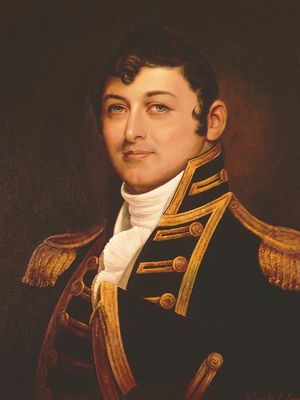

Naval History & Heritage Command photo NH 48939-KN.
Capt. Isaac Hull.
Early in life, he joined his father, a mariner, on local voyages and longer trips to the West Indies. During the mid-1790s, Hull commanded several merchant vessels, losing some to French privateers.
In March 1798, Hull was commissioned a lieutenant in the new United States Navy.and distinguished himself during the next two years while serving on board the frigate Constitution in the undeclared war with France. When troubles with the Barbary powers heated up in 1802, he went to the Mediterranean as first lieutenant in the frigate Adams. He later commanded the schooner Enterprise and the brig Argus, receiving promotions to the rank of master commandant in 1804 and to captain in 1806. During the next few years he supervised the construction of gunboats and in 1809 and 1810 was successively given command of the frigates, Chesapeake, President and Constitution.
Captain Hull’s tour in Constitution was eventful. He took the ship on a European cruise in 1811–12, returning home before the War of 1812 broke out between the United States and Great Britain. An enemy squadron closely pursued his ship off the East Coast in July, but Hull skillfully evaded them. On 19 August 1812, Constitution encountered the British frigate Guerriere at sea and pounded her to a wreck in an action that electrified the nation and demonstrated that the small U.S. Navy was a worthy and dangerous opponent for Britain's otherwise overwhelming maritime might.
For the remainder of the War of 1812, Isaac Hull commanded the Portsmouth Navy Yard at Kittery, Maine, then briefly served on the Board of Navy Commissioners in Washington before taking over leadership of the Boston Navy Yard. From 1823–1827, he commanded the U.S. squadron operating along South America’s Pacific Coast.
Commodore Hull’s next assignment, as Commandant of the Washington Navy Yard, ran from 1829 until 1835. Between 1839 and 1841 he commanded the Mediterranean Squadron.
Rendered unfit for further service by age and ill health, he spend the next two years on leave. He died at Philadelphia, Pennsylvania, on 13 February 1843.
Source: Naval Historical Center including Dictionary of American Naval Fighting Ships.